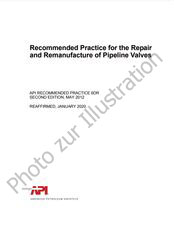Wir benötigen Ihre Einwilligung zur Verwendung der einzelnen Daten, damit Sie unter anderem Informationen zu Ihren Interessen einsehen können. Klicken Sie auf "OK", um Ihre Zustimmung zu erteilen.

API PUBL 4661-ed.2
Exploration and Production Emission Calculator II (EPEC II) User’s Guide
Name übersetzen
NORM herausgegeben am 1.1.2007
| Sprache | |
| Realisierung |
|
| Zugänglichkeit | AUF LAGER |
| Preis | AUFANFRAGE ohne MWS |
| AUF ANFRAGE |
Informationen über die Norm:
Bezeichnung normen: API PUBL 4661-ed.2
Ausgabedatum normen: 1.1.2007
SKU: NS-1139824
Zahl der Seiten: 110
Gewicht ca.: 361 g (0.80 Pfund)
Land: Amerikanische technische Norm
Kategorie: Technische Normen API
Die Annotation des Normtextes API PUBL 4661-ed.2 :
API PUBL 4661, 2nd Edition, January 2007 - Exploration and Production Emission Calculator II (EPEC II) User’s Guide
INTRODUCTION
The Exploration and Production Emission Calculator Version 2.0 (EPEC II) is a software tool that can be used to estimate emissions for exploration and production (E&P) facilities. EPEC II integrates user inputs, emission calculations, and data summaries for many equipment types common to E&P facilities. The calculation techniques and emission factors utilized by the EPEC II software were, in most cases, established by the U.S. Environmental Protection Agency (EPA), the American Petroleum Institute (API), and the Gas Research Institute (GRI). Published references that provide background information for the calculation methods used in EPEC II are given for each equipment type in both the software and in each section of this Users Guide. EPEC II can be used to estimate emissions of criteria pollutants (carbon monoxide [CO], nitrogen oxides [NOx], sulfur oxides [SOx], particulate matter under 10 µm [PM10], and volatile organic compounds [VOCs]), hydrogen sulfide (H2S), greenhouse gases (GHGs—carbon dioxide [CO2], methane, and ethane), and hazardous air pollutants (HAPs), such as benzene, toluene, ethylbenzene, xylenes, 1,3-butadiene, n-hexane, 2,2,4-trimethylpentane, formaldehyde, and acetaldehyde. The types of equipment addressed by the EPEC II software include amine units, cooling towers, diesel/gasoline internal combustion (IC) engines, external combustion emission units, fixed-roof storage tanks, flares, fugitive emissions, glycol dehydrators, loading operations, natural gas engines, natural gas turbines, and vents. The user also has the flexibility to include emissions from additional equipment types, or to use alternative means to calculate emissions.
Empfehlungen:
Aktualisierung der technischen Normen
Wollen Sie sich sicher sein, dass Sie nur die gültigen technischen Normen verwenden?
Wir bieten Ihnen eine Lösung, die Ihnen eine Monatsübersicht über die Aktualität der von Ihnen angewandten Normen sicher stellt.
Brauchen Sie mehr Informationen? Sehen Sie sich diese Seite an.



 Cookies
Cookies
